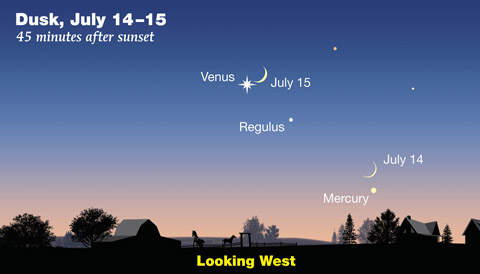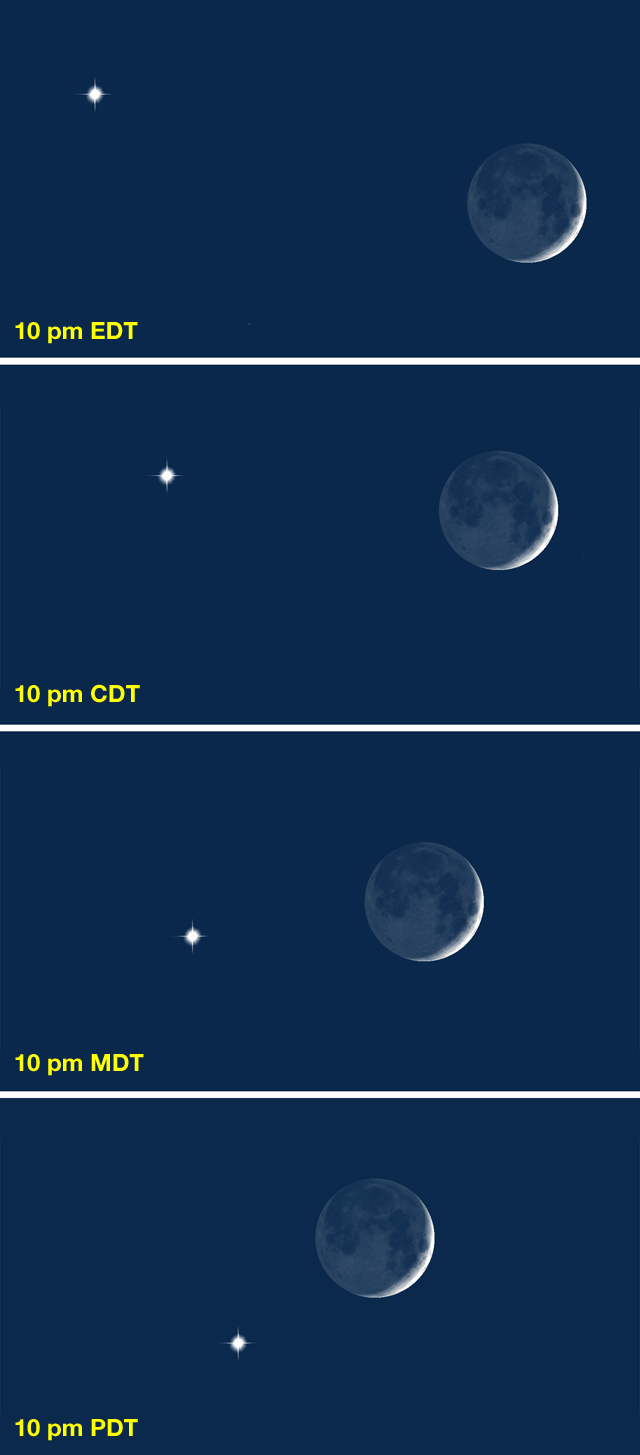The Moon and Venus will have a lovely conjunction on Sunday, July 15th.

Sky & Telescope / Leah Tiscione
Hanging dramatically in the west during evening on Sunday, July 15th, will be a bright “star” and crescent: Venus and the Moon. The cosmic couple will be quite the eye-catcher if your sky is clear.
Look for them due west as twilight fades. The best viewing will probably be from about 40 to 60 minutes after your local sunset time. Hunt for them too early, and the sky will still be too bright to display them well. Look too late, and they’ll be sinking very low on their way to setting.
Also, look carefully a little to their lower right for the star Regulus twinkling away. It’s slightly less than 1% as bright as Venus.
Moreover, you may also be able to catch the planet Mercury much farther to their lower right. A line from Venus through Regulus points straight to it. Binoculars will help. (All descriptions are for viewers in North America.)

Sky & Telescope / Stellarium
How close together the Moon and Venus will actually appear depends on where you are. Seen at dusk in the Eastern time zone, they’ll appear separated by about 2° — twice the width of your finger held at arm’s length. Seen from the West, they’ll be less than one finger apart — only ½°!
Inside the sunlit crescent, you might notice the rest of the Moon glowing dimly. What you’re seeing is called earthshine. It’s caused by the nearly full Earth in the Moon’s sky lighting up the nighttime lunar landscape – the same way the full Moon illuminates nighttime lanscapes on Earth.
If you have a telescope, this is a fine time to get it out. In addition to features on the Moon, it will show that Venus has a tiny, dazzling gibbous disk — demonstrating that this planet has Moon-like phases of its own.
Moon-Venus pairings are not unusual, but this one is more dramatic than most. Whenever Venus shines in the twilight sky, as it has been since late winter, the crescent Moon passes it once a month – though usually not so closely. For instance they’ll appear much farther apart at their next encounters on August 13th and September 11th (again for North America), and they’ll be down nearer to the horizon as well.
The glory of a Moon-Venus pairing is that these are the brightest two astronomical objects in our sky after the Sun. The Moon appears bright because it’s so close to us: about 240,000 miles, no farther than you might hope to drive a car with good maintenance and a little luck. The Moon is 100 times nearer to us than the closest planet ever gets.
“Closest planet” often means Venus, which near to us as planets go and also near to the Sun, so it gets illuminated very brightly. And it’s covered with white, highly reflective clouds.
“Close,” though, is always a relative thing in astronomy. Venus and the Moon might look like entrancing companions on Sunday night, but Venus — 88 million miles away — will be 380 times more distant.
 1
1
Comments
Bob
July 12, 2018 at 1:04 am
I am looking forward to my moment of bedazzlement.
You must be logged in to post a comment.
You must be logged in to post a comment.